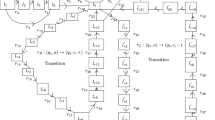Abstract
In Loos and Ogihara (Theor. Comput. Sci., 386(1-2):132–150, 2007), time complexity for splicing systems has been introduced. This paper further explores the time complexity for splicing systems and in addition defines a notion of space complexity, which is based on the description size of the production tree of a word. It is then shown that all languages accepted by t(n) space-bounded nondeterministic Turing machines can be generated by extended splicing systems with a regular set of rules in time O(t(n)2). Combined with an earlier result, this shows that the class of languages generated by polynomially time bounded extended regular splicing systems is exactly PSPACE. As for space complexity, it is shown that there exists a finite k such that for every fully space-constructible function f(n) the languages produced by extended splicing systems with a regular set of rules having space complexity f(n) are accepted by O(f(n)k) time bounded nondeterministic Turing machines. Also, it is shown that all languages accepted by f(n) time-bounded nondeterministic Turing machines can be generated by extended regular splicing systems in space O(f(n)k). By combining these two results it is shown that the class of languages generated by extended splicing systems with a regular set of rules in polynomial space is exactly NP and that in exponential space is exactly NEXPTIME.
Similar content being viewed by others
References
Book, R.V.: Time-bounded grammars and their languages. J. Comput. Syst. Sci. 5(4), 397–429 (1971)
Culik, K. II, Harju, T.: Splicing semigroups of dominoes and DNA. Discrete Appl. Math. 31, 261–277 (1991)
Gladkiĭ, A.V.: On the complexity of derivations in phase-structure grammars. Algebra Logika Semin. 3(5-6), 29–44 (1964) (in Russian)
Head, T.: Formal language theory and DNA: an analysis of the generative capacity of specific recombinant behaviors. Bull. Math. Biol. 49, 737–759 (1987)
Hopcroft, J.E., Ullman, J.D.: Introduction to Automata Theory, Languages and Computation. Addison-Wesley, Reading (1979)
Loos, R.: An alternative definition of splicing. Theor. Comput. Sci. 358, 75–87 (2006)
Loos, R., Mitrana, V.: Non-preserving splicing with delay. Int. J. Comput. Math. 84(4), 427–436 (2007)
Loos, R., Ogihara, M.: Complexity theory for splicing systems. Theor. Comput. Sci. 386(1-2), 132–150 (2007)
Ogihara, M.: Relating the minimum model for DNA computation and Boolean circuits. In: Proceedings of the 1999 Genetic and Evolutionary Computation Conference, pp. 1817–1821. Morgan Kaufmann, San Francisco (1999)
Ogihara, M., Ray, A.: The minimum DNA computation model and its computational power. In: Unconventional Models of Computation, pp. 309–322. Springer, Singapore (1998)
Papadimitriou, C.H.: Computational Complexity. Addison-Wesley, Reading (1994)
Păun, Gh.: Regular extended H systems are computationally universal. J. Autom. Lang. Comb. 1(1), 27–36 (1996)
Păun, Gh., Rozenberg, G., Salomaa, A.: Computing by splicing. Theor. Comput. Sci. 168(2), 321–336 (1996)
Păun, Gh., Rozenberg, G., Salomaa, A.: DNA Computing—New Computing Paradigms. Springer, Berlin (1998)
Pixton, D.: Regularity of splicing languages. Discrete Appl. Math. 69, 101–124 (1996)
Reif, J.H.: Parallel molecular computation. In: Proceedings of the 7th ACM Symposium on Parallel Algorithms and Architecture, pp. 213–223. ACM Press, New York (1995)
Savitch, W.J.: Relationships between nondeterministic and deterministic tape complexities. J. Comput. Syst. Sci. 4, 77–192 (1970)
Author information
Authors and Affiliations
Corresponding author
Additional information
R. Loos work supported by Research Grants BES-2004-6316 and ES-2006-0146 of the Spanish Ministry of Education and Science.
Rights and permissions
About this article
Cite this article
Loos, R., Ogihara, M. Time and Space Complexity for Splicing Systems. Theory Comput Syst 47, 301–316 (2010). https://doi.org/10.1007/s00224-008-9161-7
Received:
Accepted:
Published:
Issue Date:
DOI: https://doi.org/10.1007/s00224-008-9161-7




